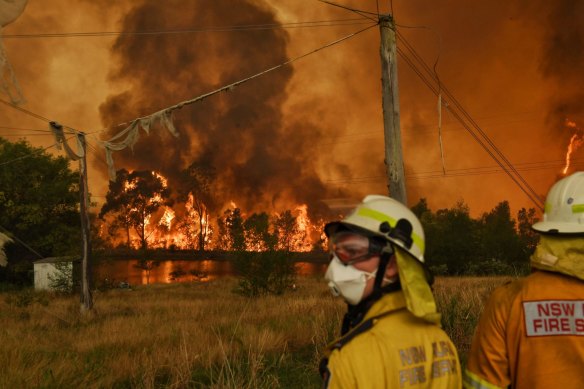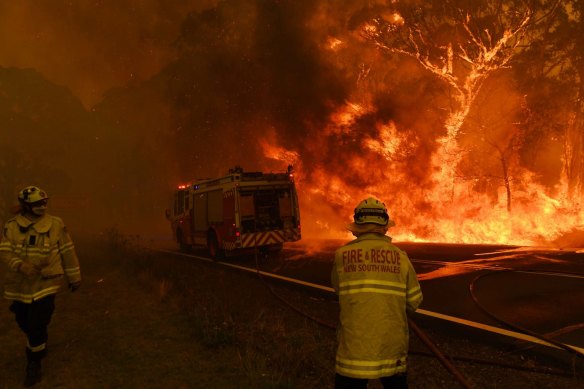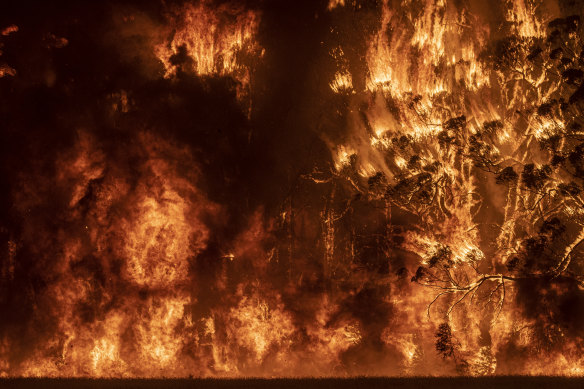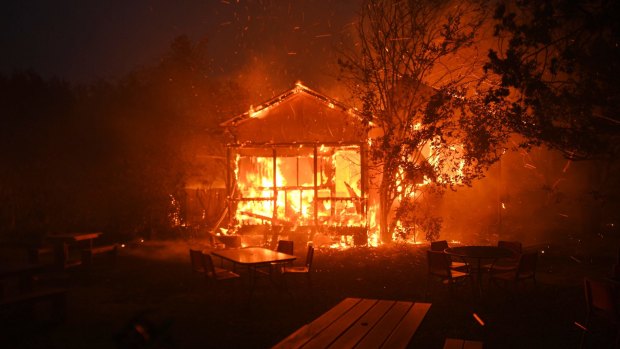By Harriet Alexander
It was the bushfire for which the term “megablaze” was coined. The Gospers Mountain Fire tore through 547,990 hectares over 107 days after starting with a lightning strike on October 26, 2019.
Now, it has emerged that nearly a quarter of the area wiped out by this blaze in 2019-20 resulted from fires lit by the NSW Rural Fire Service, according to an independent analysis that has prompted calls for a major review of bushfire fighting strategies amid another El Nino weather system.

The Gospers Mountain fire impacting Bilpin in December 2019.Credit: Nick Moir
About 54,000 hectares of the Gospers Mountain Fire was razed by the infamous Mt Wilson backburn, which subsequently jumped into the Grose Valley and became known as the Grose Valley Fire, after its ignition four years ago from Thursday.
But a report tendered to the NSW coronial inquiry into the Black Summer bushfires found that the bushfire starting at Mt Wilson was not the first time a backburn had escaped under a controversial strategy deployed by the RFS to contain the Gospers Mountain Fire.
It was in fact the sixth escaped backburn, and it was only lit to defend towns along the Bells Line of Road from another failed backburn at Newnes.
Fire scientist Nicholas Gellie, who was commissioned by local residents to analyse the Mt Wilson backburn, found that backburns had previously escaped:
- On November 15, when backburning was performed at Putty Road, the Wallaby Swamp Trail and Staircase Spur Trail at Colo Heights
- On November 19, at Putty Road, Barina Road and Wheelbarrow Ridge Road at Colo Heights
- On December 3-5, at Cerones Track, Colo Heights
- On December 5-6 at Mountain Lagoon, between Colo Heights and Bilpin
- On December 7, at Glowworm Tunnel Road on the Newnes Plateau
- On December 12, at Blackfellows Hands Trail at Newnes Plateau
Each of these burning operations were lit on days rated very high or severe fire danger and burned in the wrong direction from the Gospers Mountain Fire and many of them destroyed properties and structures.
Together they accounted for at least 130,800 hectares of damage. The RFS described each of them as the Gospers Mountain Fire.
The term “backburning” is generally used to describe a defensive fire fighting tactic that involves igniting a burn in the path of a wildfire. The backburn is sucked towards the fire front and devours the fuel, to slow down or stop the progression of the wildfire.
But in the hot, dry summer of 2019-20, when conventional firefighting techniques repeatedly failed to have the desired effect, the RFS devised what became known as the “southern containment strategy”.

The Mt Wilson backburn crossing the Bells Line of Road at Berambing.Credit: Nick Moir
The strategy involved running a 60-kilometre burn through the Blue Mountains from Colo Heights in Sydney’s northwest to Bell on the other side of the range, to blacken the entire area between those towns and the wildfire.
Gellie says the strategy was flawed because it introduced too much fire into the landscape.
“You could have limited the extent [of the Gospers fire] with small tactical backburns, not large scale backburns,” Gellie says – though he concedes it could be argued that backburning along the southern containment line ultimately protected Mount Tootie and Mountain Lagoon.
“This burning strategy wasn’t confined just to Gospers, but to Green Wattle, Currowan and so on.”

A backburn in the Grose Valley which lost control and joined with the Gospers Mountain fire in December, 2019.Credit: Nick Moir
An RFS analysis presented to NSW Parliament last year showed just 4 per cent of backburns out of the 1000 performed over the 2019-20 summer were the subject of concern.
Commissioner Rob Rogers declined to comment on the backburns specifically lit to contain the Gospers Mountain Fire until the outcome of a coronial inquiry, but said that once a fire reaches a certain size it is virtually impossible to stop without rain or backburning. The RFS also put in 6 to 7 kilometres of backburning around the same area that successfully held for weeks.
“When we put them in, there is no guarantee they’re going to hold,” Rogers said. “You’re introducing fire into the landscape, we’ve already got fire in the landscape, so it’s not ideal. But it’s the best of a bad choice.”
It was also important to remember that there were hundreds of bushfires alight at any given moment, and the RFS could not throw all its resources at any single fire, he said.
RFS witnesses told a coronial inquiry into the Mt Wilson backburn that the only other option was to wait until the Gospers Mountain Fire reached the towns.
Bell Division commander James Carter told the hearing that the RFS had accepted the only thing that would extinguish the Gospers Mountain Fire was rain, which was not predicted until January at the earliest.
“If we had not adopted the approach that we took, and continued to take consistently across the fire ground, we’d probably be having a different conversation here today, in terms of property loss and potentially life loss,” Carter said.
But Gellie, a former fire manager for the National Parks and Wildlife Service in the Blue Mountains and fire manager in Tasmania, challenged the suggestion that there were only two options available to the RFS.
The southern containment strategy enlarged the fire ground to a perimeter of 1100 kilometres, which made it even more difficult to suppress, and more attention should have been given to attacking the active fire edges by taking advantage of milder weather conditions when they occurred and using natural features of the landscape such as valleys and gullies.

Several homes were lost along the Bells Line of Road.Credit: Nick Moir
“The core area of this Gospers Mountain bushfire extent could have been reduced significantly had more priority been given to attacking the fire at every opportunity instead of an over-reliance on large scale backburning to enlarge it,” he wrote. “In many cases, the backburns escaped and ended up threatening the very communities they were intended to protect.”
The Herald asked two independent experts to review Gellie’s report. Jon Marsden-Smedley, a former fire manager with the Parks and Wildlife Service in Tasmania who is often used as an expert witness in court proceedings said – without having access to the base data – it appeared to be a plausible and reasonable assessment of what had happened during the fires.
Owen Price, director of the Environmental Centre for the Risk Management of Bushfires at the University of Wollongong, said he believed the main message that several of the backburns should not have been done, but the method by which Gellie reached his conclusions was not clear and the report contained leaps of logic.
Price was commissioned by the RFS to conduct a separate study on the effectiveness of 149 backburns put in over the summer. About half contained the fire and a quarter were implemented so far beyond the final perimeter that the wildfire never reached them. Only one created its own bushfire.
The study concluded that it was hard to judge whether fire agencies should aim to reduce the proportion of backburns in places that the wildfire never reached.
“It is a delicate trade-off decision between doing a burn that proves not to be useful against the risk of major impact if it is not done.”
Price said backburning remained the single most effective tool that could be used to protect people against bushfires. “I think what it shows is that while backburns are very effective, there are conditions that seem to make [matters] worse, so we need to find out what those conditions are,” Price said.
Start the day with a summary of the day’s most important and interesting stories, analysis and insights. Sign up for our Morning Edition newsletter.